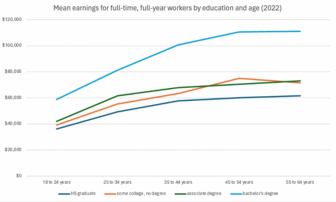Just finished reading the End of the Suburbs by Leigh Galagher, assistant managing editor at Fortune. Highly recommended.
She details, with data and stories, the new reality that more and more Americans want to live in high density, walkable, mixed use neighborhoods. Where walking and transit are as important as driving. That the odds are that we have a big over supply of housing, retail and everything else in what we think of as the typical suburb and exurb: big lot, big house, in single use neighborhoods where you have to drive long distances for anything and everything. And an equally big under supply of housing in walkable neighborhoods in both the suburbs –– predominantly inner ring and with good transit –– and central cities.
Talk about an area where we have politics –– on a bi-partisan basis both in Michigan and across most of the country –– that are designed to recreate the 20st Century. Not sure if this out-of-touch framework is worse when it comes to housing and neighborhoods or transportation (as we explored here). They are linked. And together help saddle Michigan with a preponderance of places where people increasingly don’t want to live. Not smart! And because mobile talent –– particularly college educated Millennials –– moves to where they want to live, they take the future of the Michigan economy with them when they move to those regions that offer them the walkable quality of place they increasingly are demanding.
My friends, many of whom have kids that have left Michigan for Chicago, New York and other big cities, are always astonished at the high prices their kids pay for central city housing. What I tell them is that their kids are not dopes, they know they can get the same house or apartment in Michigan for less –– in many cases far less –– but they are paying high prices –– normally rent for a generation that is increasingly renting before they have kids –– for the neighborhood, not the house.
They are looking –– and pay more –– to live in neighborhoods that look entirely different from the ones they grew up in in the suburbs. Where you can walk, bike or take transit to what you want or need to do, rather than drive. Where you can rent, not own. Where your neighbors and lots of other folks are nearby, not far away. Where their is an exciting and diverse nightlife nearby that you can enjoy everyday, not miles and miles away which you have the time to get to only every once in a while. Where houses are oriented to the front porch, not the back yard. And on and on and on.
Unfortunately our politics are far behind these trends. (As Galagher writes even far behind the big suburban/exurban housing developers, who increasingly are building walkable neighborhoods in both the suburbs and central cities.) Where our policies and politics in taxation; zoning and other regulatory areas; housing finance; transportation; etc. still greatly favor what Chris Leinberger calls drivable suburbanism over walkable urbanism. This is another area where we are having a hard time learning that what made us prosperous in the past, won’t in the future.
(For those interested in learning more about this topic, in addition to the End of the Suburbs, I also recommend reading Chris Leinberger’s The Option of Urbanism and Alan Enrehalt’s The Great Inversion.)






